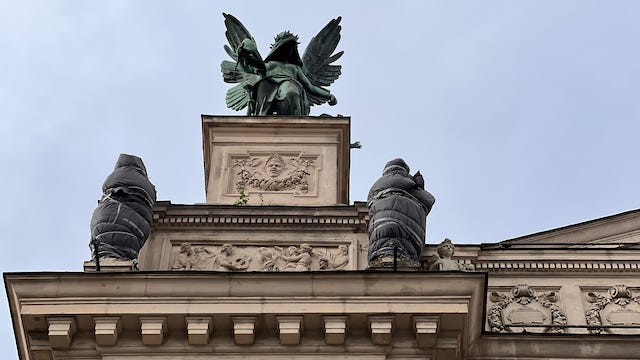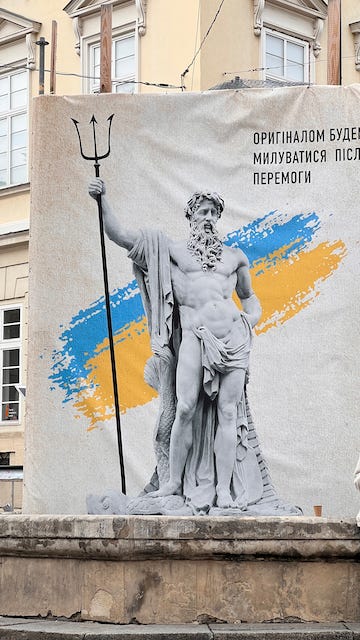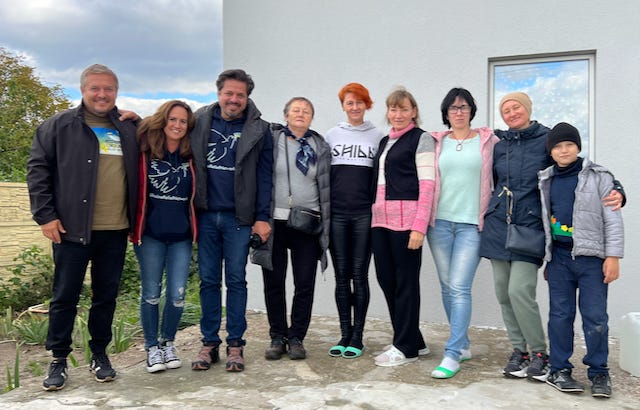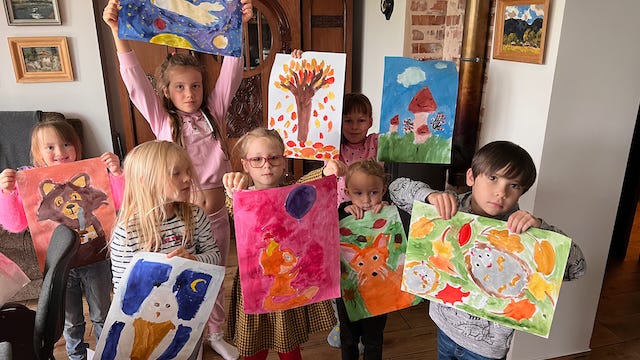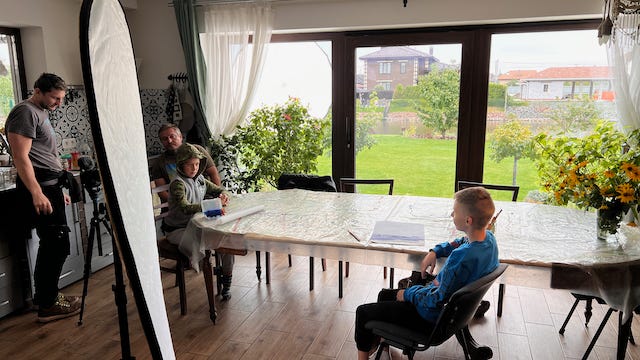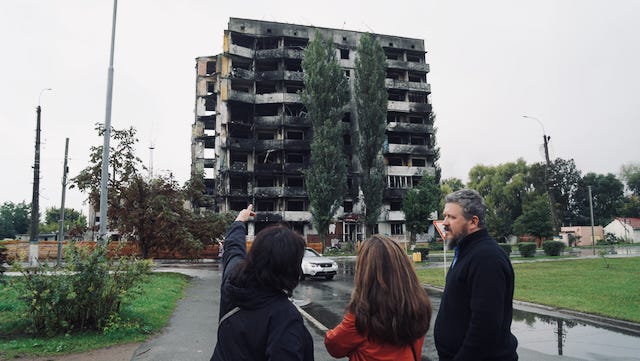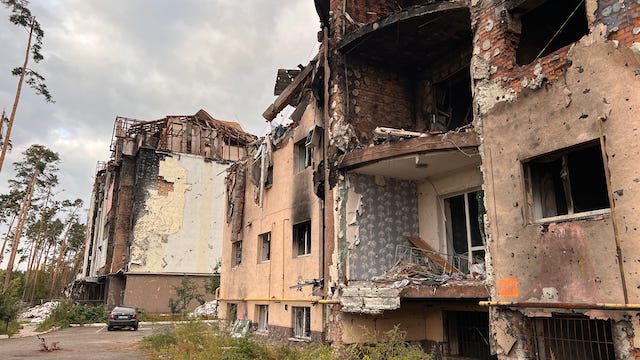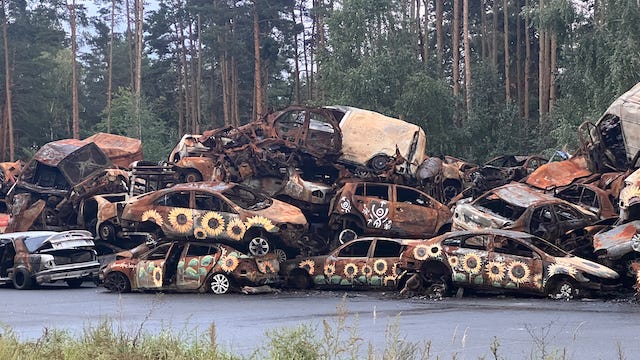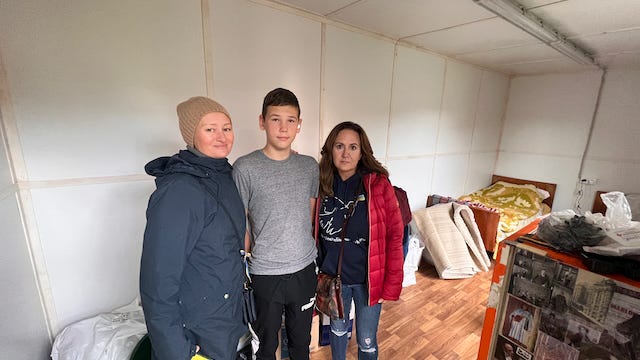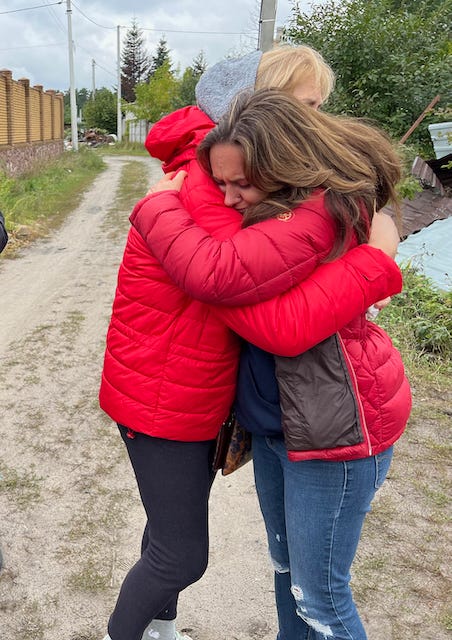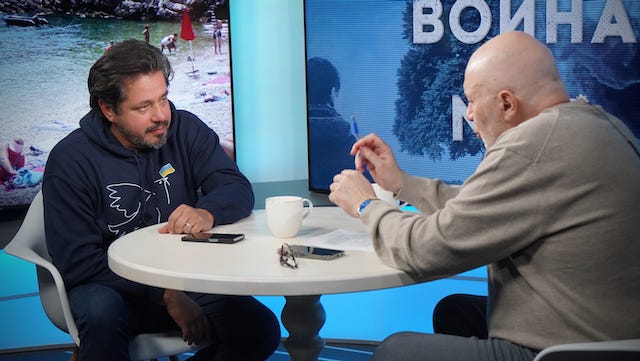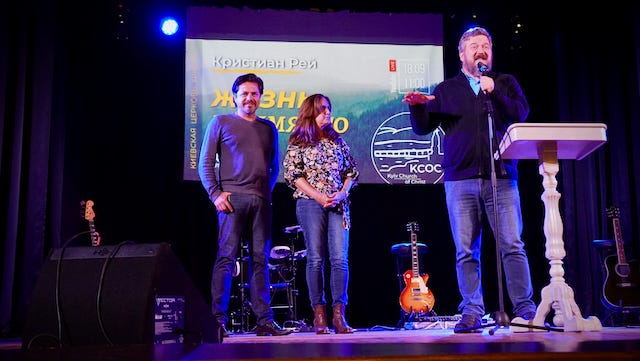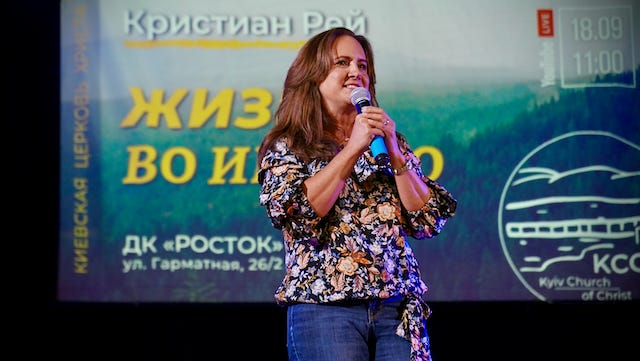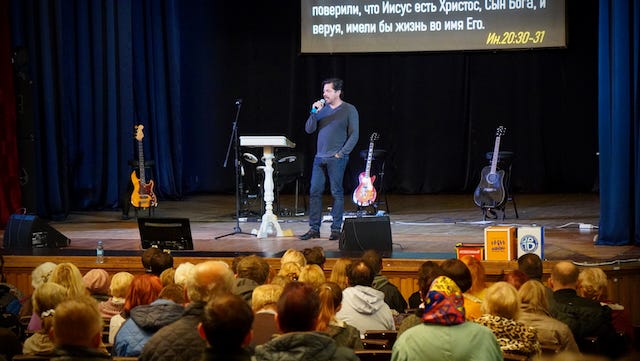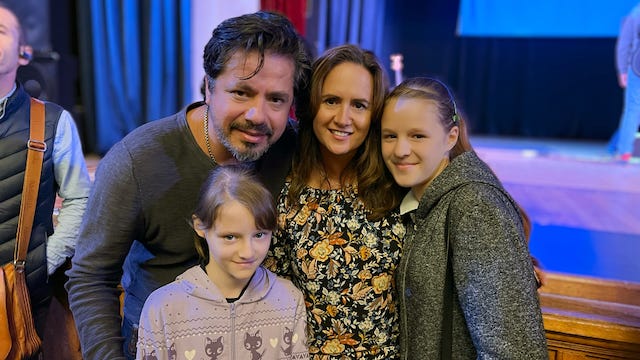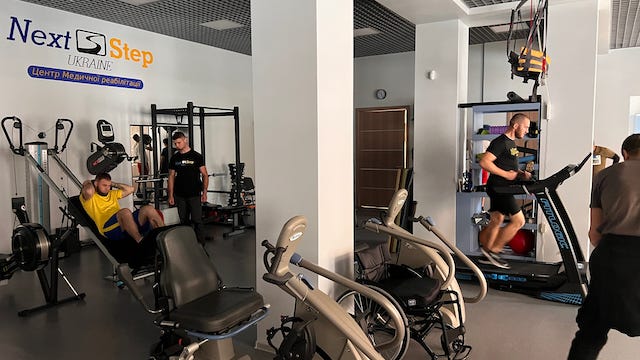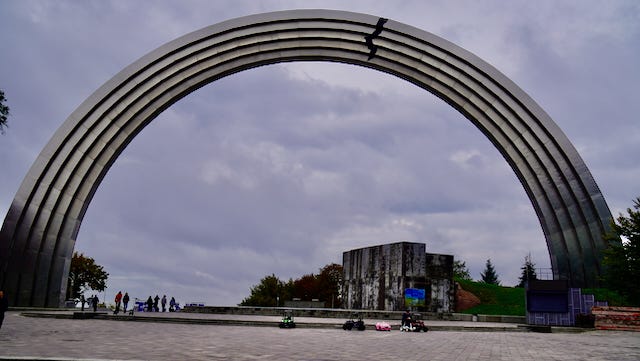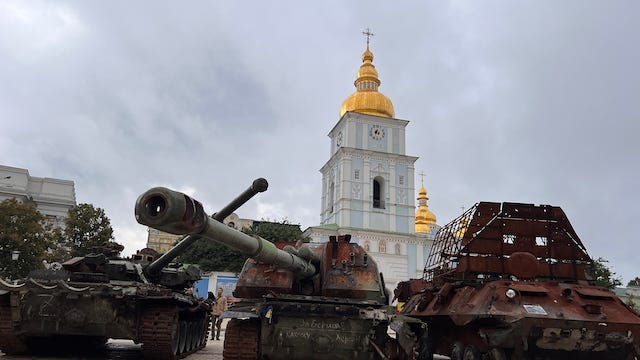We went to Ukraine and this is what we saw
Stories from our trip with the Ukraine Relief Network
The stories we heard in Ukraine could fill a book; surely, many will be written about this tragic and monumentally significant chapter in history. My wife Deb and I made a trip with the blessing of our children and friends. We went to see and express love to the many friends we have there; we went because we wanted to continue our work with the Ukraine Relief Network we started on the very first week of the war. This post is just a quick recap with lots of pictures.
To get to Ukraine, we had to fly to Amsterdam Warsaw, take a car to the border, and walk across on foot, then take another car to Lviv. Checking into the hotel in Lviv, the receptionist says with a smile, “in case of an air raid, you need to proceed to the left of the elevator into our in-hotel bomb shelter”…. good to know. Monuments, statues, and churches are covered up for some protection. The sign on the banner covering the steel cage on the statue of Neptune says, “You will enjoy the original after our victory.”
Lviv, the westernmost city in Ukraine at the border with Poland, is beautiful and historic. It is part of the UNESCO Creative Cities as a City of Literature. It’s common to hear the greeting “Glory be to Jesus” from the locals. In partnership with the Lviv Church of Christ, the Ukraine Relief Network distributes humanitarian supplies locally and sends them to Eastern Ukraine. As we shared a meal with refugees, I spoke with Elena from Izyum and asked if she would be returning home soon as the city had been liberated that week. Sadly, she told me, she has no home to return to. Elena described in great detail the experience of sitting in a cold basement for days, listening to the floors above her fall one by one until, ultimately, a rocket penetrated the basement, and the survivors had to dig their way out, passing their children through small openings to the surface.

Deb called me over to another table where she was speaking with Olga and two of her children. Olga had spent 5 months under Russian occupation in Kherson. What caused her to undertake a dangerous escape was not the looting, the killings, and the constant danger - it was the sudden disappearance of hundreds of children who did not come home from school one day because they were kidnapped by the occupying authorities and taken to filtration camps. It’s hard to wrap our minds around this even as we hear first-hand accounts from eyewitnesses of the events. Deb took off her bracelet and gave it to Olga as a reminder when she feels alone that we are here to support them and are praying for them every day.
Kyiv greeted us with the warm smile of our dear friend and head of the Ukraine Relief Network, Yuri Kovtanuk. The city is as vibrant as we remember it, with an added dark imprint of war. Military checkpoints, anti-tank structures, and trenches dug up to defend the city remain from the early weeks of the war. A heartbreaking reminder and unfolding tragedy.
We brought a full van of supplies and clothing to St. Olga’s Shelter for women. We spent a few hours over tea, listening to their stories, most of which are too graphic to describe here. While these women are healing from incomprehensible trauma, they are serving their country by creating and selling intricately crafted traditional shirts called Vyshivanka. It is clear from our first-hand conversations with dozens of eyewitnesses from completely different areas that the atrocities and war crimes committed by the Russian army in Ukraine have yet to be fully comprehended by the international community. When the full scale of the evil that is happening here is acknowledged, there are profound lessons to be learned, repentance to be had, and rebuilding to be invested in on every level.
Another Ukraine Relief program is art therapy for kids. It’s impossible to overstate the power of creative expression in healing a child’s heart. The experience was joyful and deeply moving as we saw the kids overflow with beauty and insight into colors and images. We interviewed two of the boys for an upcoming video.
A few images to visually frame the level of destruction that occurred in just a few weeks in previously idyllic suburbs around Kyiv - Bucha, Yerpen, Borodyanka, and Gostomel. There remain many areas where landmines have not been cleared out yet. Shopping centers, grocery stores, pharmacies, a maternity hospital, residential apartment buildings, schools, and private homes have been completely destroyed. ”Surgical” is not a word that comes to mind, “indiscriminate” is more appropriate. A defeated column of Russian tanks and personnel carriers is left on the side of the road for all to see. Children are playing around the destroyed buildings. A washing machine is hanging out of the jagged edge of a building, exposing a kitchen, bedrooms, and living rooms. A mosaic depicting a woman in a traditional Ukrainian dress at the entrance of a restaurant is the only thing left intact. A cemetery of Ukrainian civilian cars full of shrapnel and bullet holes. Artists have painted sunflowers on them as a statement of their resilience, the victory of beauty over violence. Wherever we went, locals generously shared their experiences. The sense of collective grief is so thick you can practically feel it on your skin; it is heavy on our hearts. One mother and her son came up to us, as we took pictures of a large apartment building with the middle section bombed to the ground. She cried and pointed to the edge on the right and explained that her father-in-law lived on the 9th floor. She said the Russian planes were flying so low she could see the pilot. After hours of driving around, I just stopped taking pictures. It was all the same everywhere we went, in these residential areas that were only briefly occupied by Russian soldiers. I can only imagine how devastating it is in the areas that have been under occupation for many months.
One snapshot of tens of thousands of similar stories: We brought supplies, a rug, and a piece of furniture to Natasha and her grandson. This is what remains of her beautiful two-story home, their life savings. They now live in a storage trailer behind the ruins; winter is coming. Natasha washed some apples so she could offer us something and express her gratitude. Our eyes welled with tears at the sight of such hospitality.
Irina, a neighbor in the same village, came over to talk to us. She lost everything; her family is now dispersed, her daughter serves in the army, and Irina takes care of her elderly father and handicapped grandson. It’s hard for her to find food consistently. We gave her the cash we had in our pockets. She said, “I just shake in grief. I have no tears left.” Deb hugged her and said, “I will cry for you.”
I had the opportunity to join a friend and prominent journalist, Matvey Ganapolsky, live on air to discuss the cultural, moral, and historical implications of the war. Matvey himself experienced bombing and barely escaped an intense firefight in the early days of the assault on Kyiv.
We were asked to speak at the church we used to lead in Kyiv on Sunday and were blessed to be reunited with so many old friends. They have been through so much suffering. Love, hugs, tears, and smiles, rejoicing with those who rejoice and mourning with those who mourn. Unforgettable moments of connection and togetherness.
After church, we met Rita and her sister Sofia, who spent several weeks in a basement under occupation in Bucha. Their stories are heartbreaking, but their spirit remains unbroken; they have hope and have been adopted by a family in the church.
Dima Yashekov is a friend and world-class videographer. With his help, we produced a video of the Ukraine Relief Network. Dima lives in Yerpen, and his house has major damage from the war; he lives in the one intact room in his house while his wife and children escaped from the bombing to Germany. This is our last day of filming with our new partners, Revived Soldiers. Next Step is the new physical rehabilitation center for wounded soldiers. Their previous location was destroyed by a bomb. We have been able to supply them with exercise equipment for their new facility. They need more centers to help as many soldiers recover as soon as possible.
Our last day in Kyiv was very emotional. Saying goodbye to dear friends. Visiting favorite spots, as beautiful as ever now marked by the tragedy of war. The iconic Independence Square lawn is filled with thousands of flags for lost lives and has notebooks for people to add stories of lost loved ones. We had just learned that a member of our church, Anatoly Tchaikovsky, was killed in the war. We wrote a few words in the notebook and shed some tears in silence. The world needs to know. The world needs to help. It is not just a Ukrainian tragedy; it is a tragedy for the world and Europe descending to a state of barbaric war we hoped was never to be repeated.

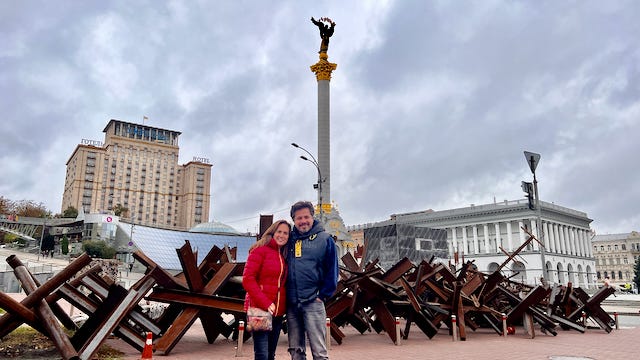

The Ukraine Relief Network is our way to contribute to the healing and rebirth of Ukraine. Our goal is to connect local charities doing remarkable work on the ground, to tell their stories to the world, and to partner with compassionate and generous donors and organizations who want to be part of the healing and rebirth of Ukraine.
If you are in a position to help in any way - please follow our Facebook page for updates and visit our website to give, or just leave a note here to get in touch with me. Please continue to pray for peace in Ukraine.
P.S. A jarring reminder of the brutality and randomness of the attacks came in the morning of October 10th, 2020. The bridge Deb and I stood on on our last day in Kyiv was blown up.
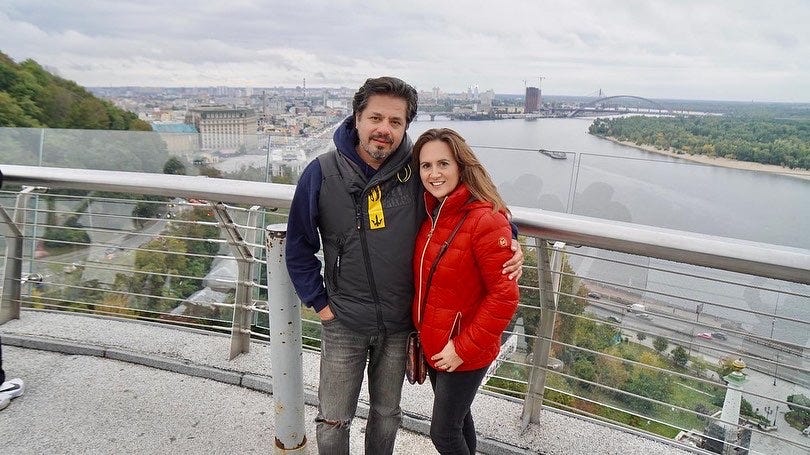
Pray for peace.





